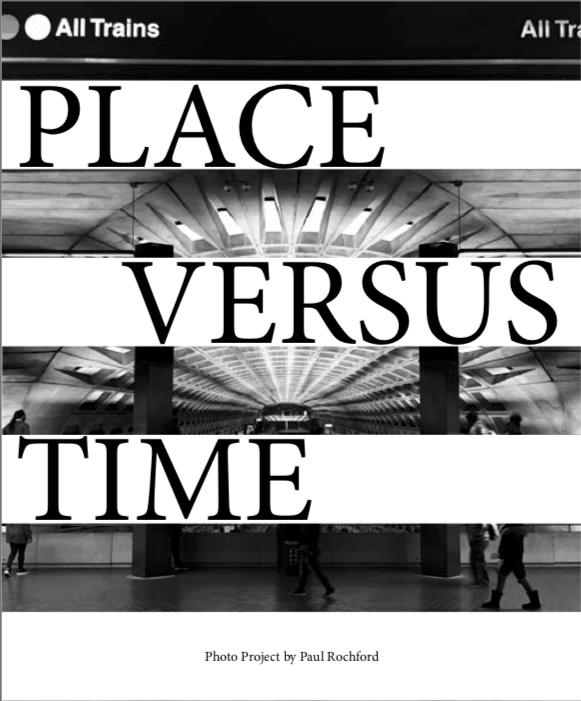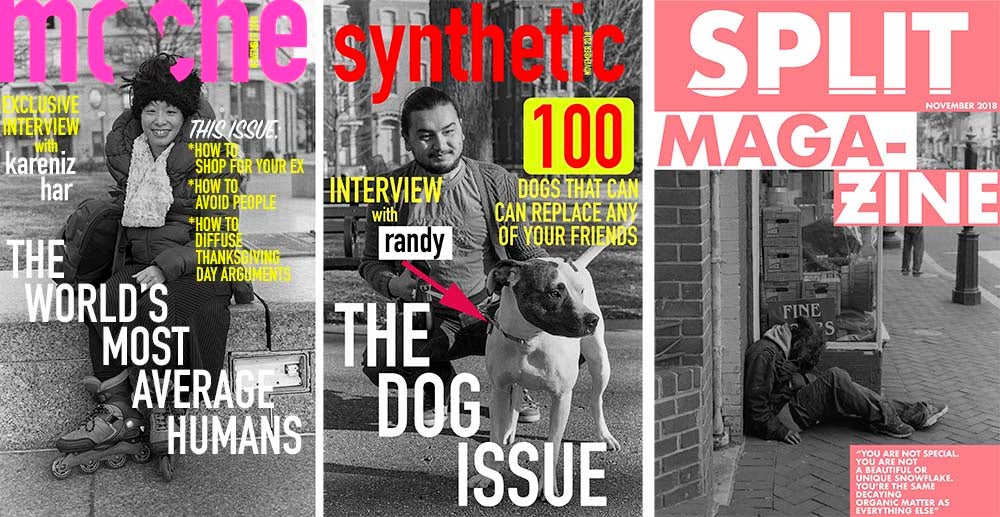Spring 2022 Course Guide
Welcome to the Spring 2022 Course Guide for the Department of Art and Art History!
We invite you to browse all the offerings and let us know if you have any questions. For individual courses, please reach out to the professor. For other questions about your major, minor, or our curriculum more generally, please contact your major advisor or any of us listed below. Department faculty and staff are happy to answer your questions and discuss your options by email or appointment.
Director of Undergraduate Studies in Art History – Prof. Ian Bourland
Director of Undergraduate Studies in Studio Art – Prof. John Morrell
Director of MA Program in Art and Museum Studies – Prof. Lisa Strong
Department Chair — Prof. Elizabeth Prelinger
Department Coordinator – Em Aufuldish
Jump to…
Studio Art Courses
Design
ARTS 100-03 – Design I
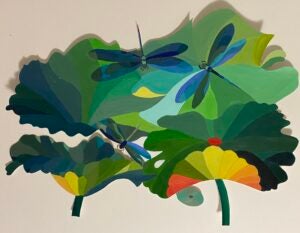
Camouflage Project: In Design I, we cover color mixing and color theory. In this project, by Elena Zheng, the students were asked to think about the idea of camouflage and how to integrate two or more natural or man made objects by thinking about their color placement and arrangement.

Experimental color compositions: In this project (seen here: Professor Dowley’s demonstration) students use their own photographs of architectural spaces to develop two simplified color compositions. One of the compositions will be monochromatic (one primary color is chosen as a starting color) and the other is developed from complimentary colors.

Paper Cutting: Students learn to cut intricate designs using only paper and x-acto knives. Students develop their images from their own photography and from drawings.(student work: Cornelia Thomas)
ARTS 100-03 — Design I is an introductory art studio course. Using drawing, painting, sculpture and photo materials, students learn the principles and elements of design necessary to communicate and express themselves visually. Special topics include collage and papercutting. ARTS 100 is required for all art majors and is recommended for art minors and as an elective for students interested in exploring the discipline of studio art.
This course is taught by Professor Michael Dowley.
ARTS 100-04 – Design I

Alexandra Smalto, Paper Luminary Project

Angela Liu, Color Cube Project

Assignment covering Line and Plane Elements with Repetition and Difference Principles
ARTS 100-04 – Design I focuses on the study of fundamental skills used for making visual art. This includes both conceptual and technical development. The broad goals of the course are to train our eye to understand and refine compositions as a way to communicate ideas visually and create new designs that get past cliche ideas. Additionally, we will gain foundational skills and concepts needed for making and analyzing art. This section of Design will focus on creating three-dimensional forms using easy-to-manipulate materials such as paper, cardboard, foam-board and wire. With these materials all of the projects will be achievable in practically any learning environment.
This course is taught by Professor Evan Reed.
Drawing
ARTS 110-01 – Drawing I: Visual Language
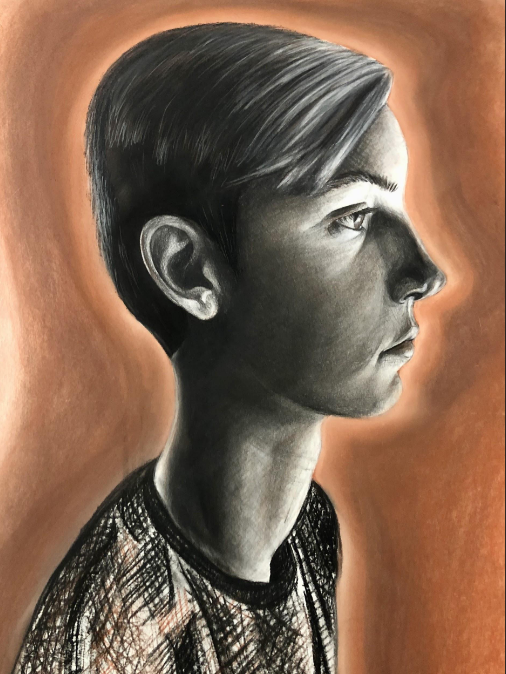
Peris Lopez, Profile Portrait Drawing

Anastasia Wass, Drawing Glass
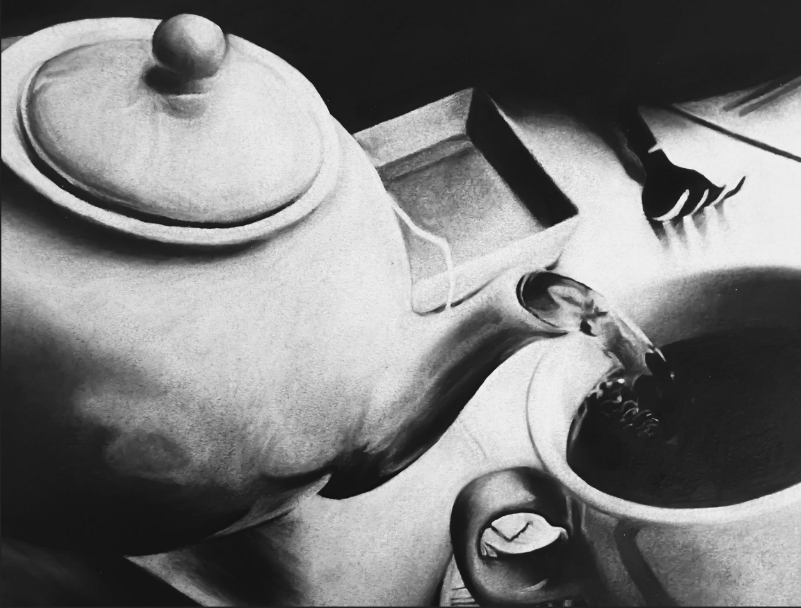
Julia Gigante, High Contrast Drawing
ARTS 110-01 – Drawing I: Visual Language Gustav Klimt once said, “Art is a line around your thoughts.” In this course, students will use drawing as a means of creative reflection and as a means to process the world around them. Students will draw inspiration for their work from their personal-history and surrounding environments. They will learn to see the world from a new perspective, and with fresh eyes. This course will begin with foundational material, building step by step in complexity. Students will use checklists to help them to develop and fix line drawing, shading, and composition. Understanding that students have different levels of drawing experience, I work with each student individually to help them improve. Using interactive group critiques and one-on-one feedback from me, all students will gain valuable feedback on their drawings. A variety of drawing processes and techniques will be covered. Subjects covered will include still life, landscape, portraiture, the figure, and architectural perspective drawing. As a remote course, resources will include prerecorded demonstrations, live-recorded demonstrations, slideshow lectures, and short films about artists.
This course is taught by Professor Mark Anderson.
ARTS 110-02 – Drawing I: Visual Language

Adam Bozzone, Positive Negative Space Composition

Hunter Spillan, Drawing from Memory

Mark Alabam, Final Project: How the Global Pandemic Affects You and Your World
ARTS 110-02 – Drawing I: Visual Language is a course designed to introduce basic fundamentals of drawing, with an emphasis on perceptive and technical skills. Basic art elements, and principles of art are explored as they relate to graphic expression. Additionally, this course is designed to develop basic drawing skills using a variety of media and techniques, and to become knowledgeable of various topics, and vocabulary in drawing such as line, tone, perspective, proportion, and composition. Another purpose of this course is to develop basic critical skills in visual art, and to expand elements of visual and critical thinking, and visual vocabulary.
This course is taught by Professor Tom Xenakis.
BACK TO TOP
ARTS 110-03 – Drawing I: Visual Language

Madison Langdon, Charcoal Value Study

Claire Jin, Fantastical Landscape Perspective Project
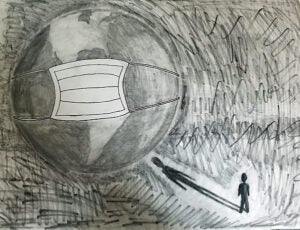
Ian Estevao Final Project: How the Global Pandemic Affects You and Your World
ARTS 110-03 – Drawing I: Visual Language is a course designed to introduce basic fundamentals of drawing, with an emphasis on perceptive and technical skills. Basic art elements, and principles of art are explored as they relate to graphic expression. Additionally, this course is designed to develop basic drawing skills using a variety of media and techniques, and to become knowledgeable of various topics, and vocabulary in drawing such as line, tone, perspective, proportion, and composition. Another purpose of this course is to develop basic critical skills in visual art, and to expand elements of visual and critical thinking, and visual vocabulary.
This course is taught by Professor Tom Xenakis.
ARTS 110-04 – Drawing I: Visual Language
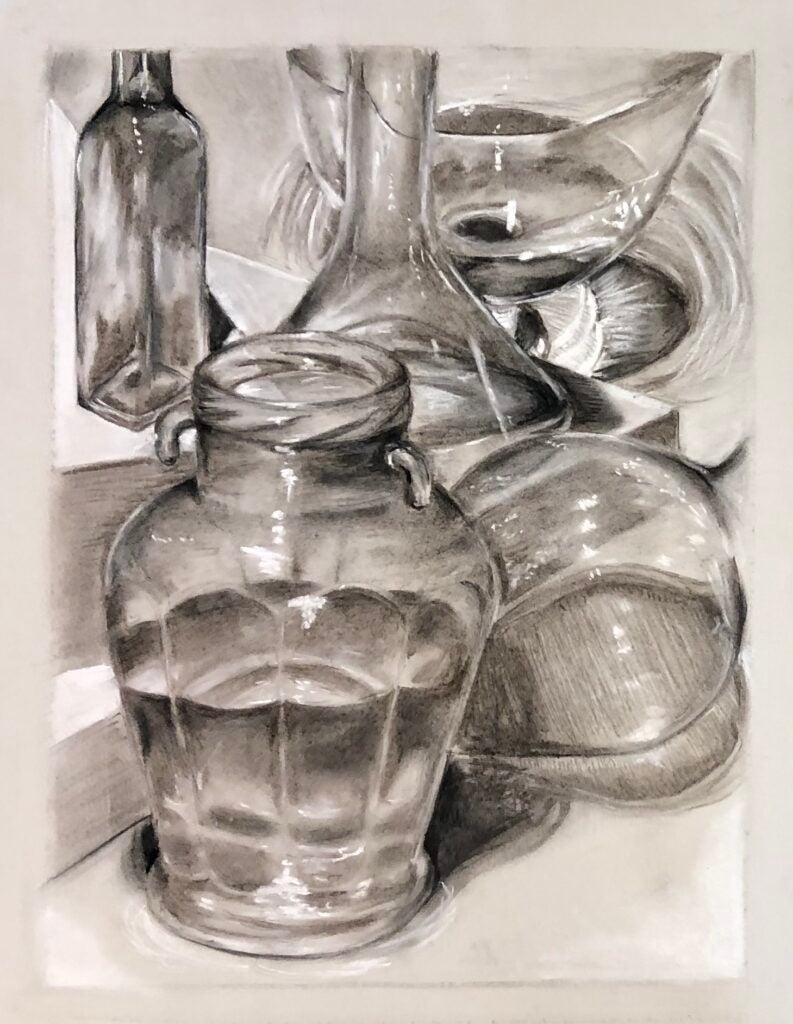
Jenna Royson, Reflections

Kent Hall, Flower study

Jade Murphy, Ballet Slippers
ARTS 110-04 – Drawing I: Visual Language In this course, students explore drawing as a graphic means to process the world around them. The class starts with the fundamentals of composition, and how to use light and shadow to describe form. We then look at line as a means of discovery and expression, along with other techniques of rendering form, space and texture. Projects range from still life and interiors to studies of nature, animal skulls and the portrait/figure. Students are approached on an individual basis as well as through group discussions, slideshows, demonstrations and critiques. “Learning to draw is really a matter of learning to see.” – Kimon Nicolaides.
This course is taught by Professor Ann Schlesinger.
ARTS-211 — Drawing II: Figure
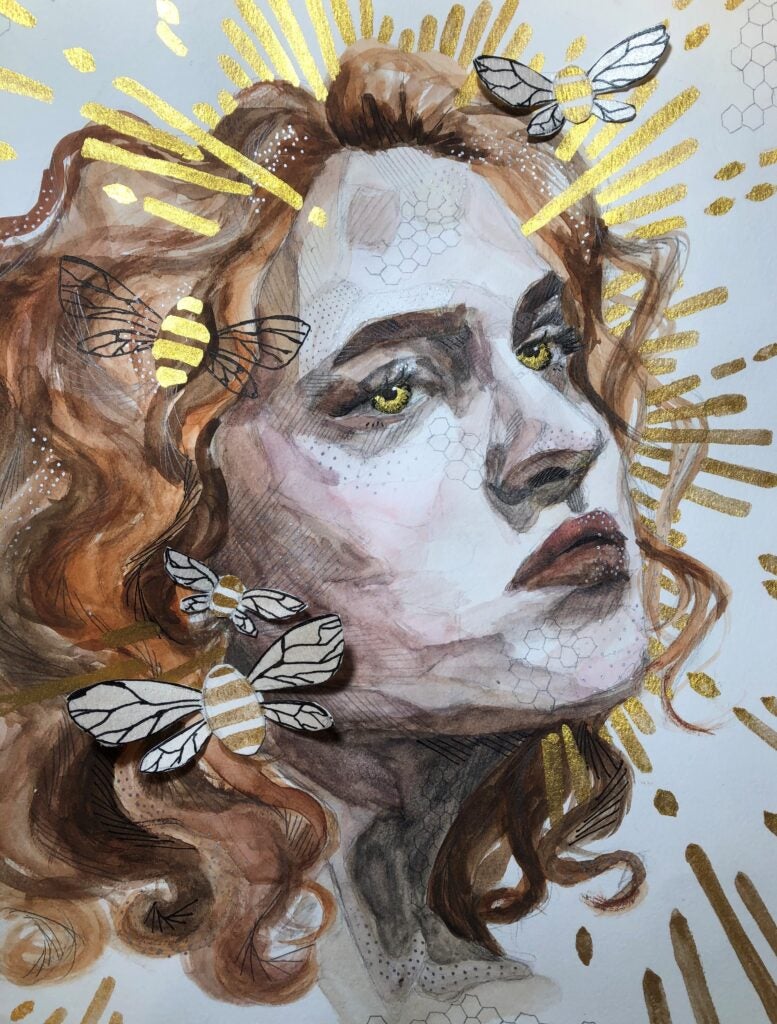
Nell DiPasquantonio
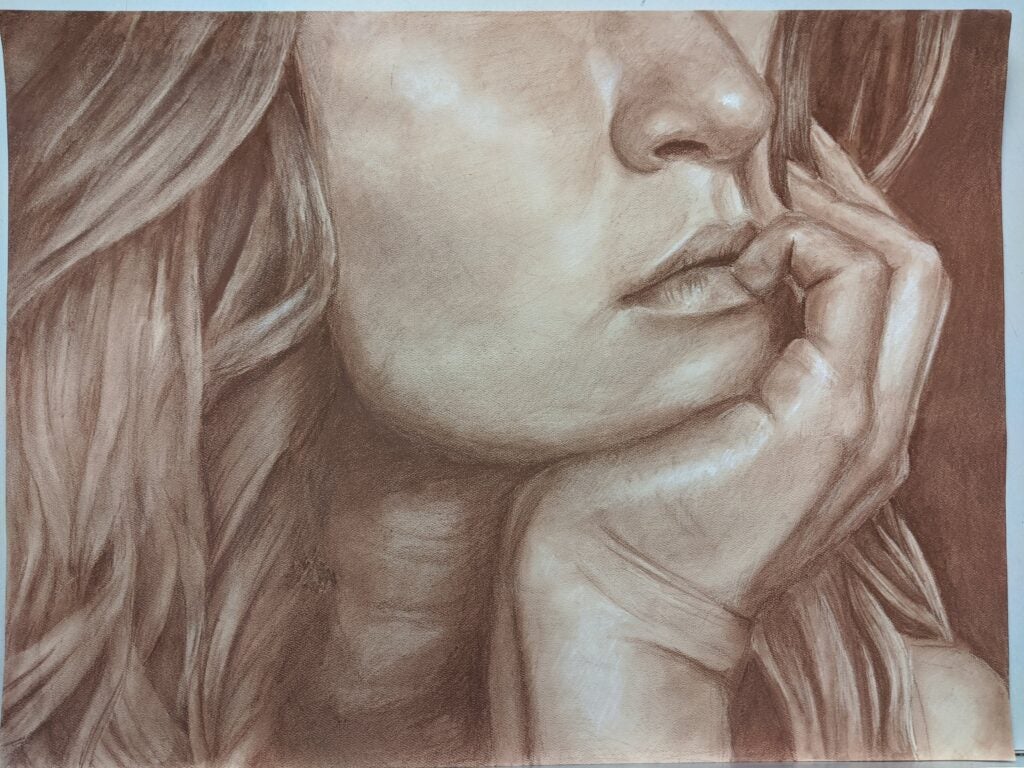
Izzy Hansen
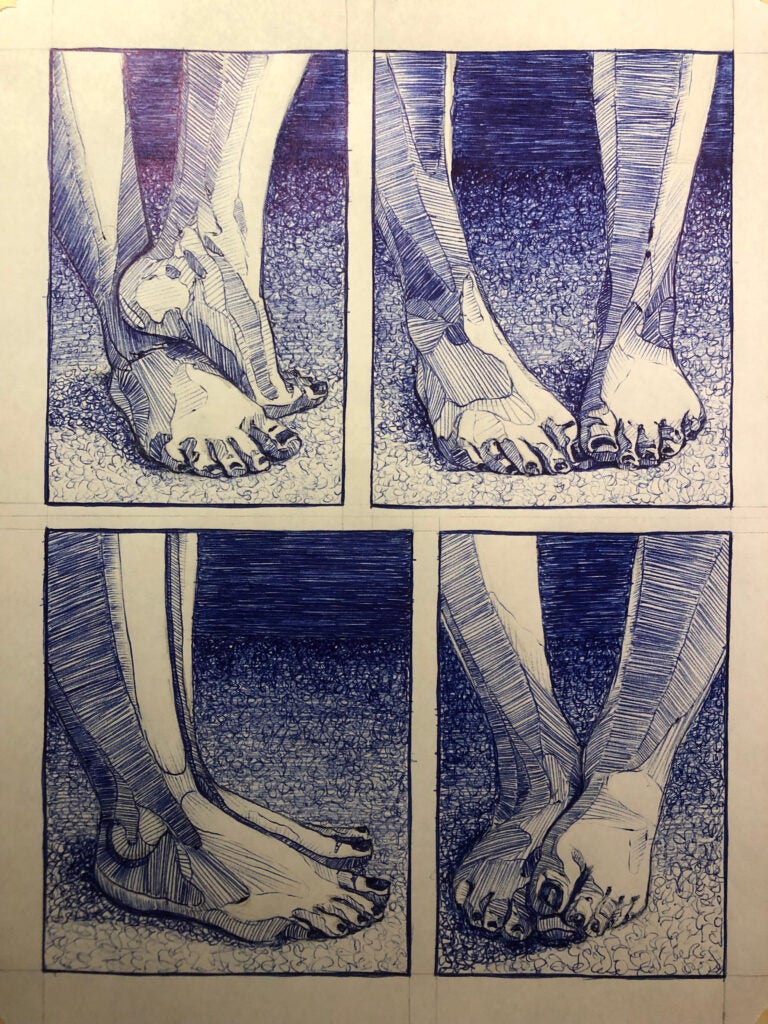
Egan Barnitt
ARTS-211 — Drawing II: Figure — This course is an exploration of the figure through a variety of mediums and tools of expression with the purpose of applying them towards the creation of an individualized and cohesive body of work. You will be expected to work both in-class and independently on a variety of projects. Every drawing in this class will contain skill-building elements and also encourage you to use your own unique aesthetic and individual critical decision-making skills. Class critiques will also be incorporated into the course and each student will develop the importance of presentation and the ability to analyze and critique using the vocabulary of visual art.
This course is taught by Professor Scott Hutchison.
ARTS-213 — Drawing into Color
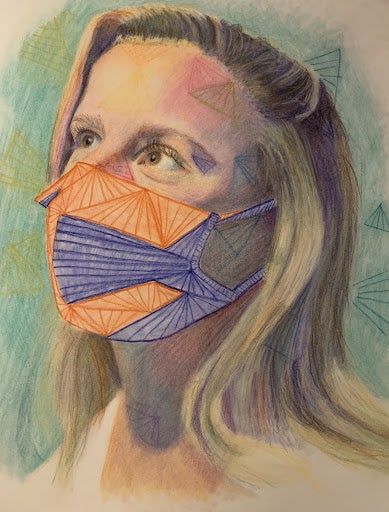
Grace Bowman

Izzy Hansen
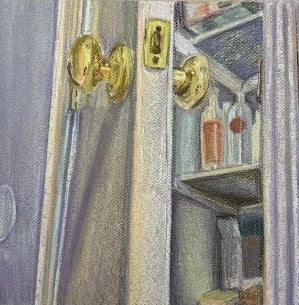
Elaine Wong
ARTS-213 — Drawing into Color covers the technical aspects of drawing through both historical and contemporary means. The goal of this course is to strike a balance between traditional approaches to color and the use of a variety of pigments with your own unique vision and individual critical decision-making skills. We will spend most of our time drawing, however students will also take part in critiques and discussion on their work, hands-on demonstrations, slide shows and artist lectures/videos so that students can experience art in a larger historical and cultural context.
This course is taught by Professor Scott Hutchison.
Printmaking
ARTS 121 — Intro to Printmaking

Grace Nguyen
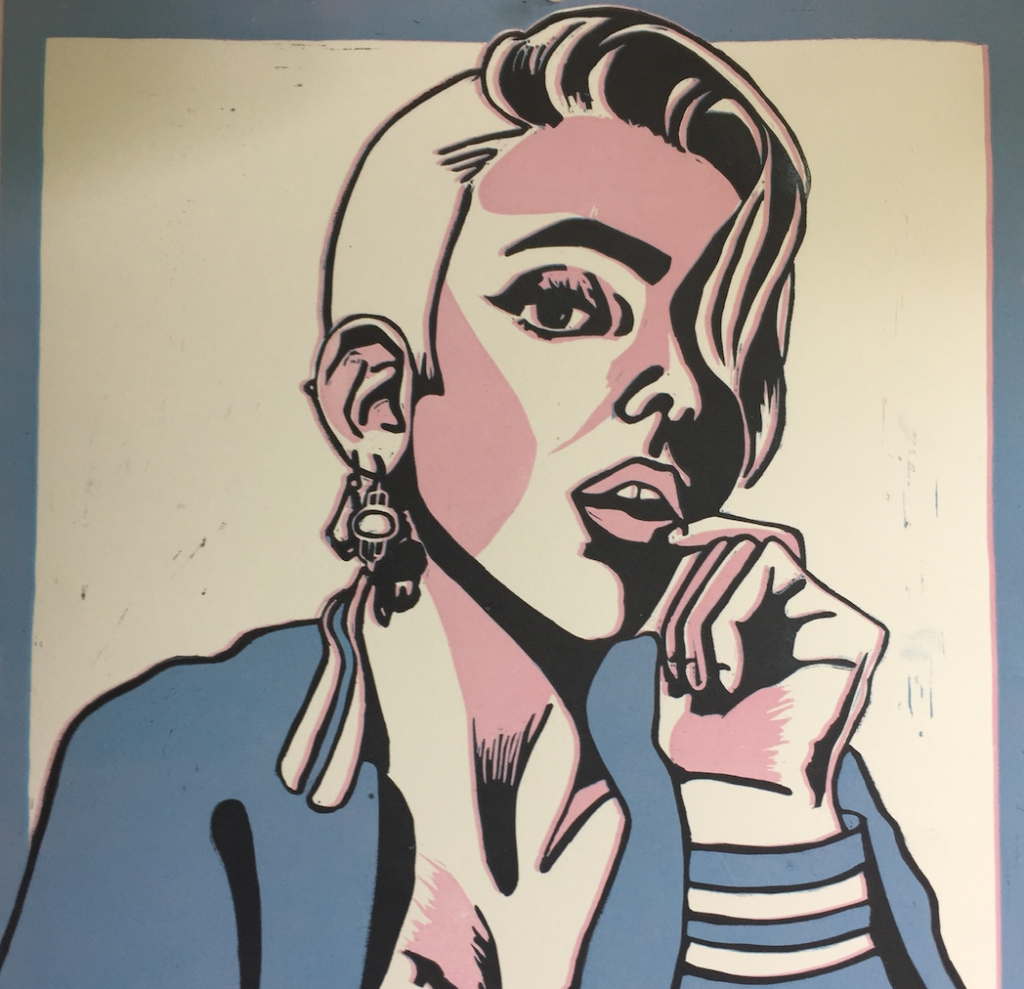
Tyler McConville

Grace Nguyen
ARTS 121 — Intro to Printmaking This course utilizes traditional hand printing of relief images from Linoleum plates. Test plates are done in color and B&W. Folds and simple bookmaking are presented as options. After learning safe cutting, registration and printing methods, students are encouraged to pursue their own personal imagery. Critiques and view and response of videos and online print related sites is required.
This course is taught by Professor Scip Barnhart.
ARTS 170 — Art of the Book

Olivia Tatarian

Jordyn Jones
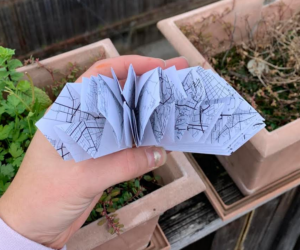
Olivia Tatarian
ARTS 170 — Art of the Book This course explores the practice and creation of unique artist books. Multiple bindings, sewing, folds, cutting methods, and techniques are taught to prepare students for personal expression through handmade books.
This course is taught by Professor Scip Barnhart.
Photography
ARTS 131-01 – Photo 1: Digital

Abel Teffra, Fall 2020

Valerie Sanchez, Summer 2020

Leo Arnett, Summer 2020
ARTS 131-01 — Photo 1: Digital is a basic digital photography studio art course designed to develop the hands-on skills necessary to produce and identify the elements of a good photograph and to acquire a thorough working knowledge of digital equipment. Students will gain an understanding of the aesthetic and technical areas of photography as a fine art. Class lectures, discussions and digital assignments will deal with photographic composition, criticism and history. Fundamental knowledge of computer programs such as Photoshop will be introduced in the semester to develop photographic imagery.
This course is taught by Professor Kelly Carr.
ARTS 131-02 – Photo 1: Digital
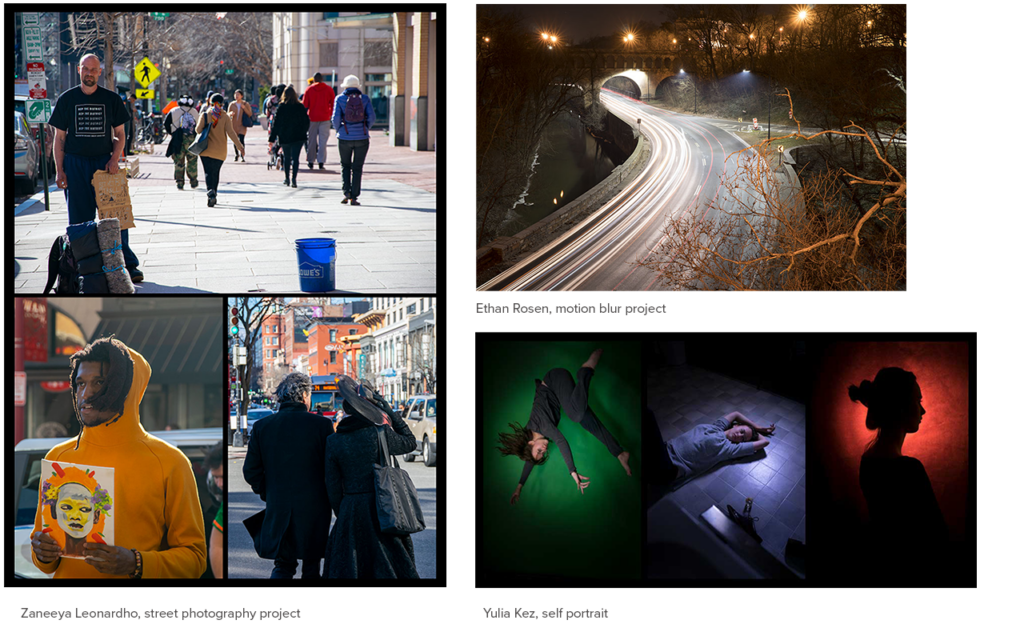
ARTS-131-02 — Photo 1: Digital is an introductory digital photography studio art course designed to develop the hands-on skills necessary to produce and identify the elements of a good photograph and to acquire a thorough working knowledge of digital equipment. Students will gain an understanding of the aesthetic and technical areas of photography as a fine art. Class lectures, discussions and digital lab assignments will deal with photographic composition, criticism and history, camera and paper types, and printer systems. Fundamental knowledge of computer programs such as Photoshop will be covered for students to edit and print their work. Students enrolled in studio courses must devote a minimum of FOUR TO SIX hours per week outside of class to develop and complete assignments. Through the analysis of the history of this medium this class involves the study of photography as a metaphor for the human condition with students engaging in self-reflection and questioning through analysis, inquiry, dialogue and creation. This course fulfills the Georgetown HALC (Humanities, Art, Literature and Culture requirement) requirement.
This course is taught by Professor Roberto Bocci.
ARTS 131-03 – Photo 1: Digital
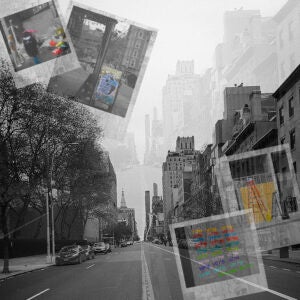
Andrea Cano, Final portfolio work

Carl Wegner, Final portfolio work
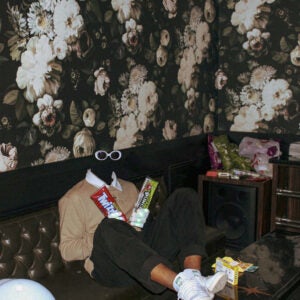
Final portfolio work.
ARTS 131-03 — Photo 1: Digital Photography plays a predominant role in how we explore and express ourselves, how we connect. Even after the pandemic, that will still be true. This class explores how the craft challenges, the cultural framework, and the photographer’s perspective are potential tools to help be better at making and understanding photographs. The sample images are student’s final portfolios from Fall 2020. I am humbled by how much progress the students made even as we explored without the possibility of brainstorming face-to-face around a table.
This course is taught by Professor Bruce McKaig.
ARTS 132-01 — Photo I: Alternative Processes

Cyanotype – Silhouette with Photograms using rosary, plant life and nails.
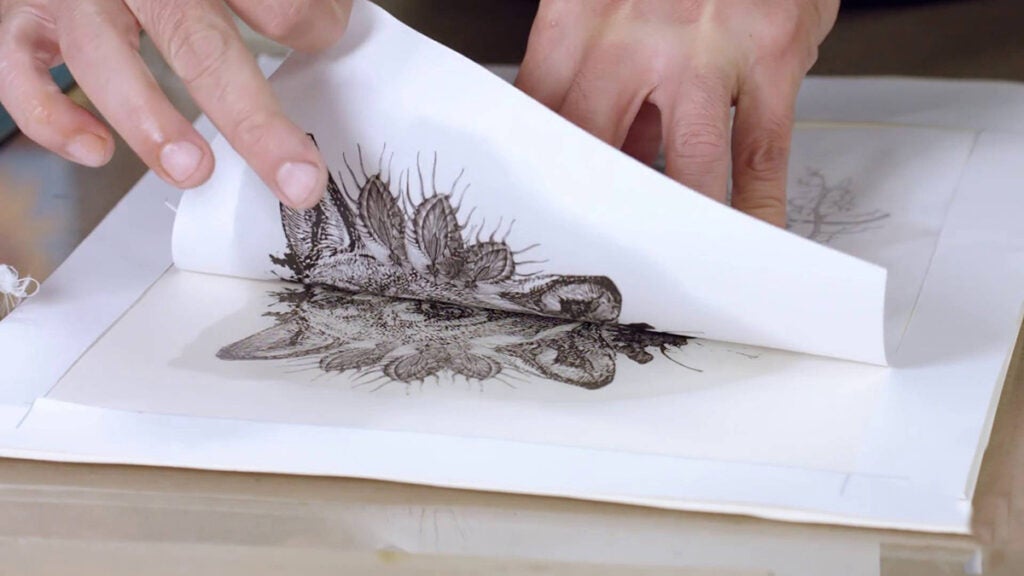
Gesso Transfer Print
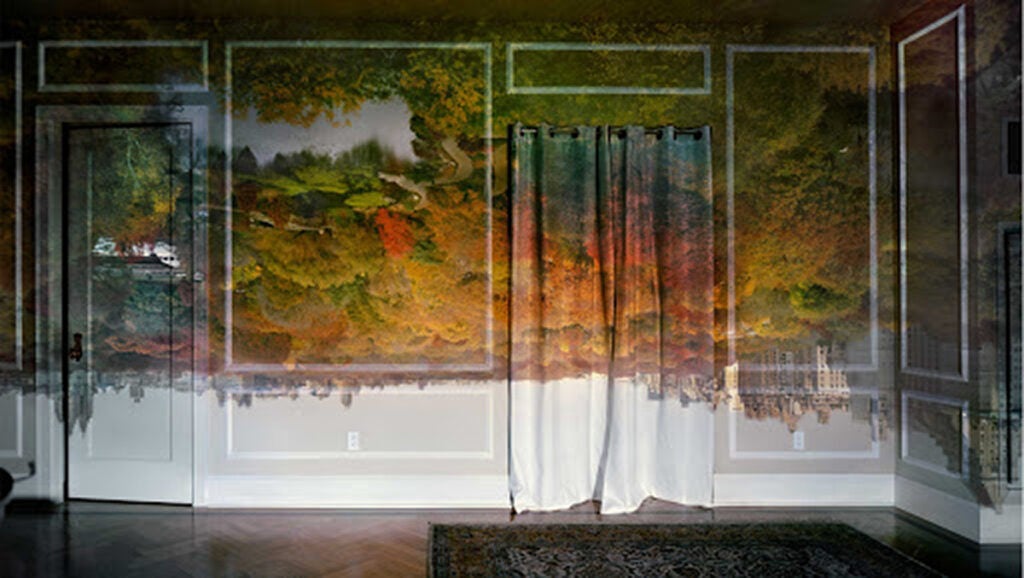
Camera Obscura
ARTS 132-01 — Photo I: Alternative Processes Back in the day meets modern day, contemporary alternative photographic processes. This class combines modern day technology with historic non-traditional printing and photographic processes. DSLR cameras and photo editing software are applied to centuries old photographic processes. Students will gain knowledge of both digital and hands-on non-traditional processes. Additionally, the class will include discussions as to history, invention, and contemporary artist regarding each process. **This class will be taught in two locations – Picchi Lab at Gelardin and Walsh 202. The instructor will indicate days for each location in the Syllabus.
This course is taught by Professor Kelly Carr.
ARTS 132-02 — Photo I: Alternative Processes

Ambient Light Gelatin Silver Print
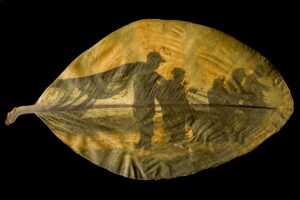
Chlorophyll Print (photo on leaf)
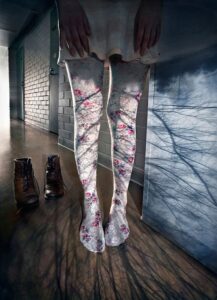
Photograph inside a camera obscura
ARTS 132-02 — Photo I: Alternative Processes This alternative photography studio art class challenges boundaries between historical techniques and contemporary means of expression. Students will discover a diversity of photographic processes, often without a camera, to explore how relevant they are to individual voice and contemporary art practices. Processes include but are not limited to cyanotypes, chlorophyll prints (photographs on plant leaves), pinhole photography, hand coloring, flip-books and other rudimentary motion processes, social media. Mostly a production class, students will also be introduced to other historical and contemporary examples through presentations, recorded as well as live on Zoom. No experience necessary.
This course is taught by Professor Bruce McKaig.
ARTS 230 – Photography Studio II
ARTS 230 – Photography Studio II is an advanced class for both film and digital photography students to continue shooting and printing their creative work in order to compile a portfolio that can be used to apply for internships, jobs or graduate school. Projects include the portrayal of a city (Washington DC and/or other), event documentation (the documentation of street events, political protests, rock concerts etc.), a book-making project that can be printed and bound in-house or sent out to companies like Blurb, and mini projects to learn how to use advanced Photoshop compositing and editing techniques. Projects can be developed on film or digital format and printed as gelatin silver and/or digital prints. As students produce work the prints are inserted into a hard copy portfolio or added to a website. The primary software packages you will use is Adobe Photoshop and Bridge and/or Adobe Lightroom.
This course is taught by Professor Roberto Bocci.
Sculpture
ARTS 140-01, -02 – Sculpture I
There are two sections of ARTS 140, at different times.

Sidney Lee, Modeling from life
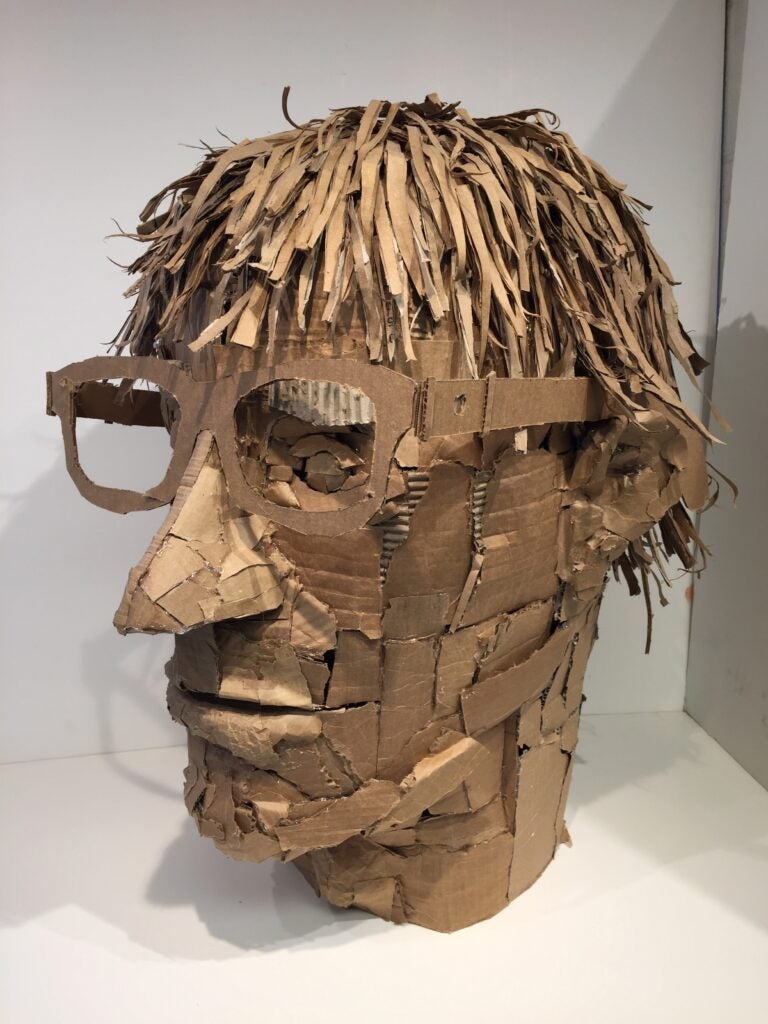
Sean Letendre, Cardboard self-portrait

Corine Forward, Spring 2019, Micro Monument Assignment
ARTS 140-01, -02 – Sculpture I offers students the opportunity to exercise their creative drive and objectify their ideas as three-dimensional form. Students work in traditional and contemporary methods and materials. During the semester there are three thematically driven projects that simultaneously introduce new materials, processes, and conceptual consideration. Assignments begin with demonstrations and example images of work by artists of different eras and previous students from Sculpture One. This spring semester Sculpture I will include projects that range from modeling a form in clay, creating sculptures with recycled cardboard and designing a miniature monument that will incorporate a range of materials. All sculptural processes will be low tech and accessible to all.
This course is taught by Professor Evan Reed.
Painting
ARTS 150-01 – Painting I: Oil

Kristina Ravensbergen, Portrait.

Lola Bushnell, Landscape painting.
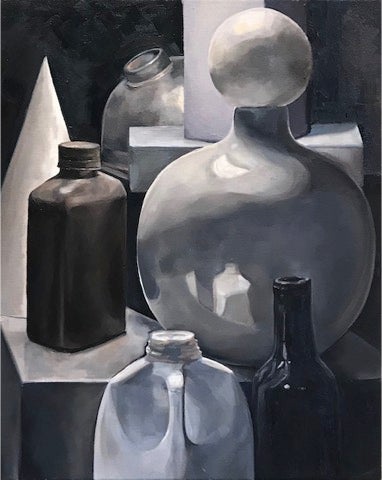
Sonya Fares, Limited palette painting.
ARTS 150-01 — Painting I: Oil Edward Hopper once said, “If I could say it in words there would be no reason to paint.” In this course, students will use paint as a means of creative expression and as a means to explore their individual interests. Students will gain inspiration for their work from their personal-history and surrounding environments. They will learn to see the world from a new perspective, and with fresh eyes. This course will begin with foundational material, building step by step in complexity. Students will explore color theory and composition. Understanding that students have different levels of painting experience, I work with each student individually to help them improve. Using interactive group critiques and one-on-one feedback from me, all students will gain valuable feedback on their drawings. A variety of painting processes and techniques will be covered. In addition to still life, students will be able to do landscape and figure paintings. As a remote course, resources will include prerecorded demonstrations, live-recorded demonstrations, slideshow lectures, and short films about artists.
This course is taught by Professor Mark Anderson.
ARTS 150-02, -03 – Painting I: Oil
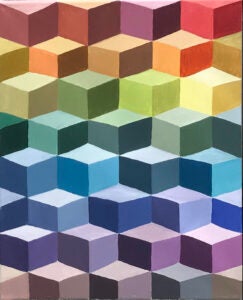
Julia Tolfa.
Oil on canvas.
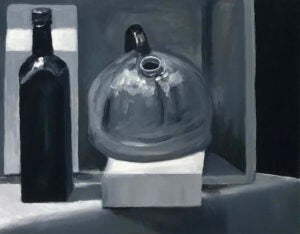
Ethan Clark
Oil on canvas.
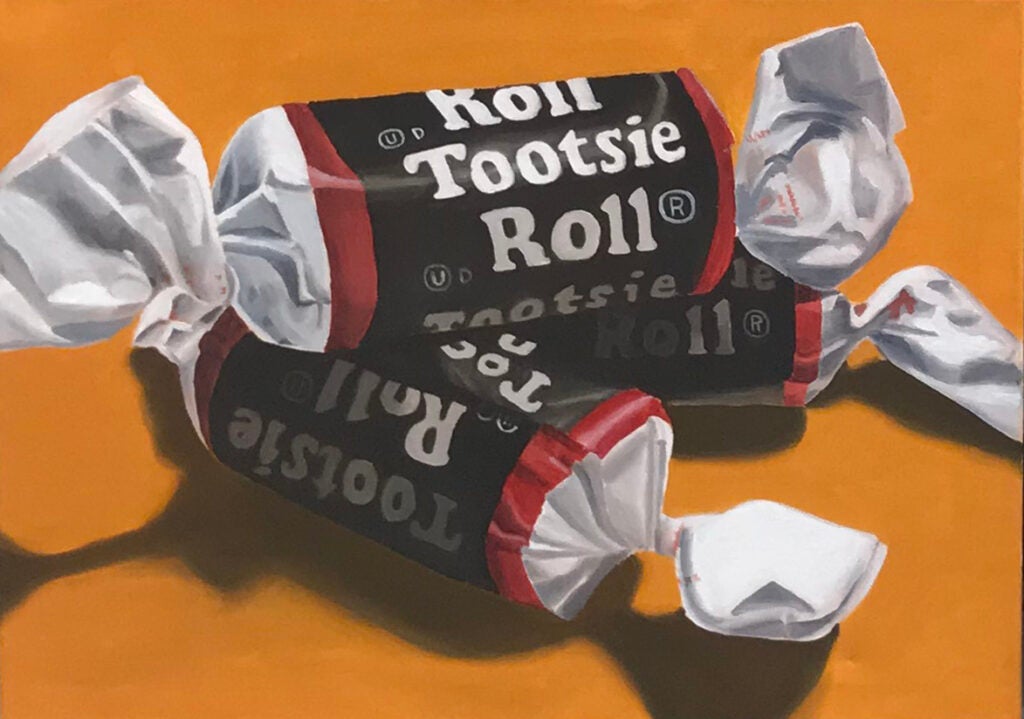
Julia Tolfa.
Oil on canvas.
ARTS 150-02, -03 — Painting I: Oil, is a studio art class developing the techniques and concepts of painting in traditional, oil medium used from the Renaissance to today. Students will learn the basic techniques of transparent glazing and opaque oil painting. They will investigate the impact of color and value on the illusion of space and form. While focusing on the traditional subjects of landscape, still life, and figure, they will create a portfolio of three paintings developing their drawing and painting abilities with the medium. Studio demonstrations, lectures, slide presentations and individual and class critiques will be conducted in person and online using Zoom and Canvas to present all aspects of instruction. Students create oil paintings during regular class sessions with feedback from the instructor. They continue to develop their paintings outside of class. The students receive individual guidance and evaluations from the instructor during each class as well as valuable insights from the student discussions during class critiques.
This course is taught by Professor John Morrell.
ARTS 151 – Painting I: Acrylic

Painting by Katie Flynn

Painting by Dane Tedder
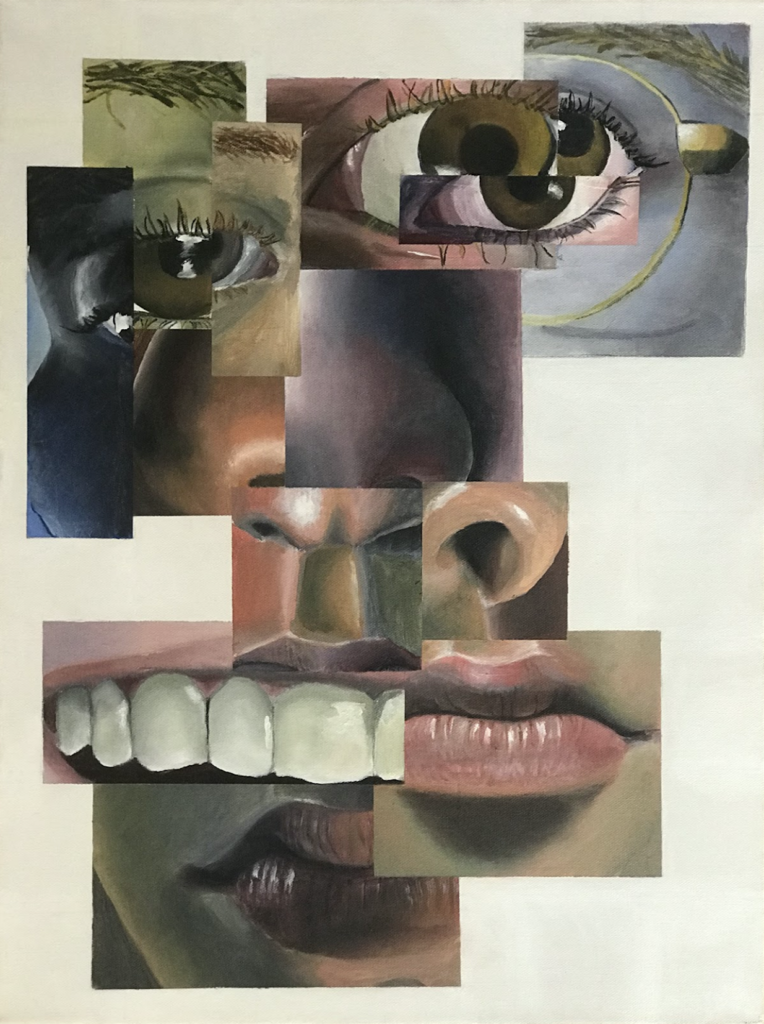
Painting by Caleb Ernst
ARTS 151 – Painting I: Acrylic This is an introductory course that consists of lectures and studio labs. This course focuses on both the acquisition of fundamental knowledge of acrylic painting, and the creation of paintings using one’s own unique imagery. Relevant art historical references and resources will be introduced in order for students to contextualize their work in reference to art history. Students will utilize critical thinking and problem-solving skills by doing progressively challenging assignments. As they work on these assignments throughout the semester, they will develop a more sophisticated aesthetic approach in the areas of color, composition, perspective, balance, and subject matter. There will be five class critiques (four critiques for each individual assignment and the last final critique for the entire course) throughout the semester and each student will have opportunities to discuss their work as well as the work of others.
This course is taught by Professor BG Muhn.
ARTS 250 — Painting Studio II

Jude An, Project 1: Conceptual Container

Christina Shoucair, Project 1: Conceptual Container

Sharon Huynh, Project 2: Human Body
ARTS 250 — Painting Studio II This is an intermediate-level painting course. The overall theme of the assignments for the semester is moving away from straight observational painting and exploring imagination and visual dynamism within a juxtaposition of the real and the unreal, blurring the boundaries between dream and reality and consciousness and the subconscious. This will be the overarching idea for all three projects while each project deals with a specific subject matter. Relevant references and resources will be introduced for students to contextualize their work using art history. Assignments begun in class will require time outside of class to develop and complete. Medium: either oil or acrylic.
This course is taught by Professor BG Muhn.
Graphic Design
ARTS 162 01 – Intro to Graphic Design

Dakota Access Pipeline protests, also called by the hashtag #NoDAPL .
Students had studies the bauhaus design and did research on the DAPL and created poster designs.
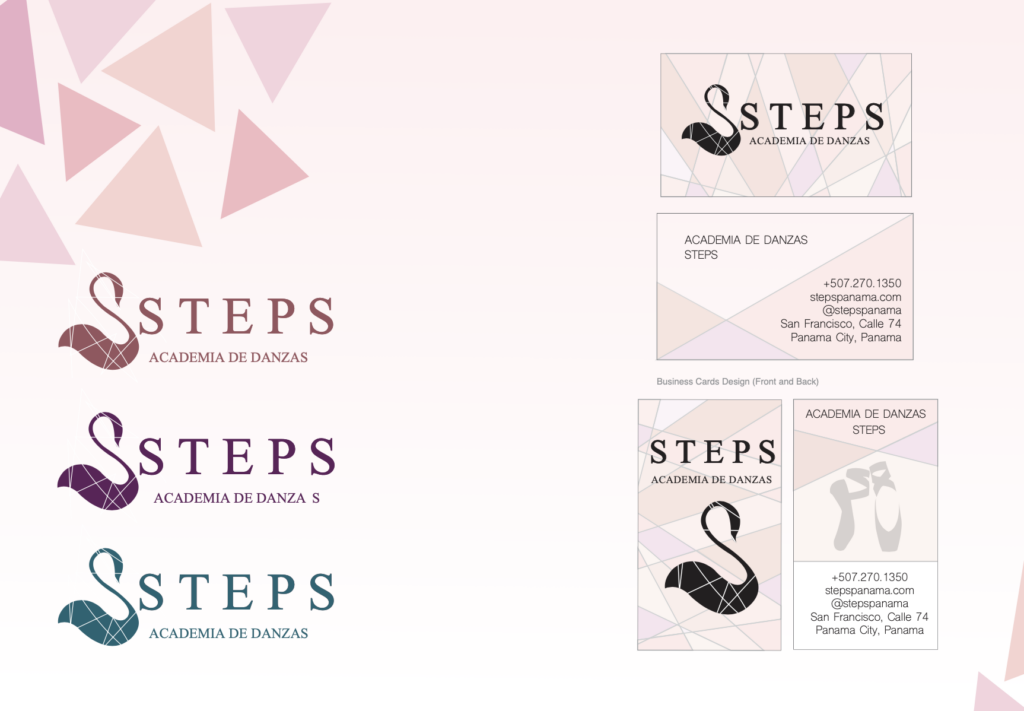
After learning the tools in illustrator and talking about branding and typography students design a logo, do variations and design business cards for the business and learn about the printing process. Work by Michelle Motta.
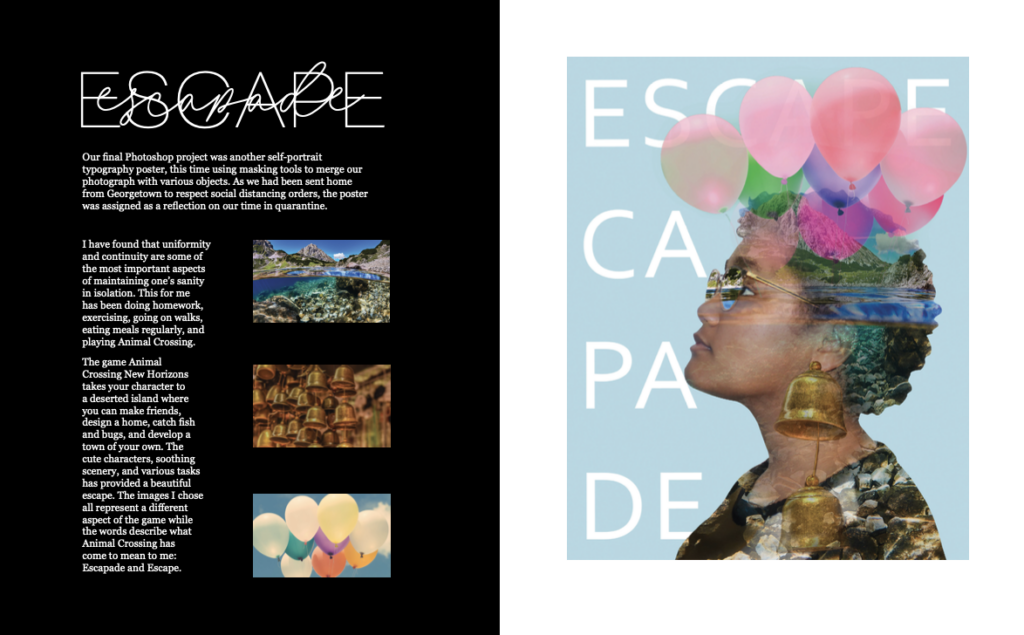
Students learn to do a portfolio newsletter in InDesign for their projects. This a spread from Nia Jordan’s portfolio.
Arts 162-01 — Introduction to Graphic Design: Students will learn the formal, aesthetic, and communicative aspects of creating effective graphic images. Projects include logos, typography, and digital arts that promote mastery of techniques, methods, and materials. In order to foster creativity, we start with breathing meditation at the start of class, followed by discussions about design and learn the Adobe software and the foundation of design principles. The goal of this class is to strengthen students’ visual literacy and communication skills as part of their liberal arts education.
This course is taught by Professor Negar Nahidian.
ARTS 162 02 – Intro to Graphic Design

Student multilingual print and interactive magazines based on chosen topic, major or minor

Chiara Lewis, translation drawings, pre-logo

Angela Perez, logo design and branding, laser etched and cut Maker Hub promo item
ARTS 162 02 — Intro to Graphic Design is a studio art class focused on the creation of graphic design assets for print and screen-based media. During this course, you will learn basic Adobe Illustrator, Adobe Photoshop, and Adobe InDesign software through real-world projects and current topics in graphic design. The course seeks to familiarize design students with the communicative power of visual form and to help students develop a personal process of creating original graphic forms capable of effectively communicating a message or information. Projects integrate the following topics: principles of graphic design, design research, logos and branding, album cover design, interactive and print publication design, typography, graphic design history, and professional portfolios.
This course is taught by Professor Toni-Lee Sangastiano.
ARTS 262 — Graphic Design II

Bauhaus Poster: Consume More Art, Create More Art
After studying the Bauhaus, students were asked to do a poster project based on the Bauhaus principals Design, typography and use of color. Top left: Shana Bottom left: Kate Gregory Bottom right: AndresSiles-Loayza Top right: Edson Martinez

Happiness book:
Students were asked to do the layout and design of a book and send it to print.
They were asked to use Adobe illustrator and photoshop for the images and Adobe Indesign for the layout and typography. Work by Juliette Silvain.

Quarantine Cusine book:
Each student was asked to share their one favorite recipe and to design and do the typography and layout of a spreading he book. Work by Anne-Isabelle de Bokay.
ARTS 262 — Graphic Design II Students will learn the mindful, formal, aesthetic and communicative aspects of creating effective graphic images. Typography, the history of type, type classifications and more will be taught and discussed. Students will design a book in Indesign and send to print, along with a type classification project cards, and other projects.
This course is taught by Professor Negar Nahidian.
Animation
ARTS 166 — Introduction to Animation
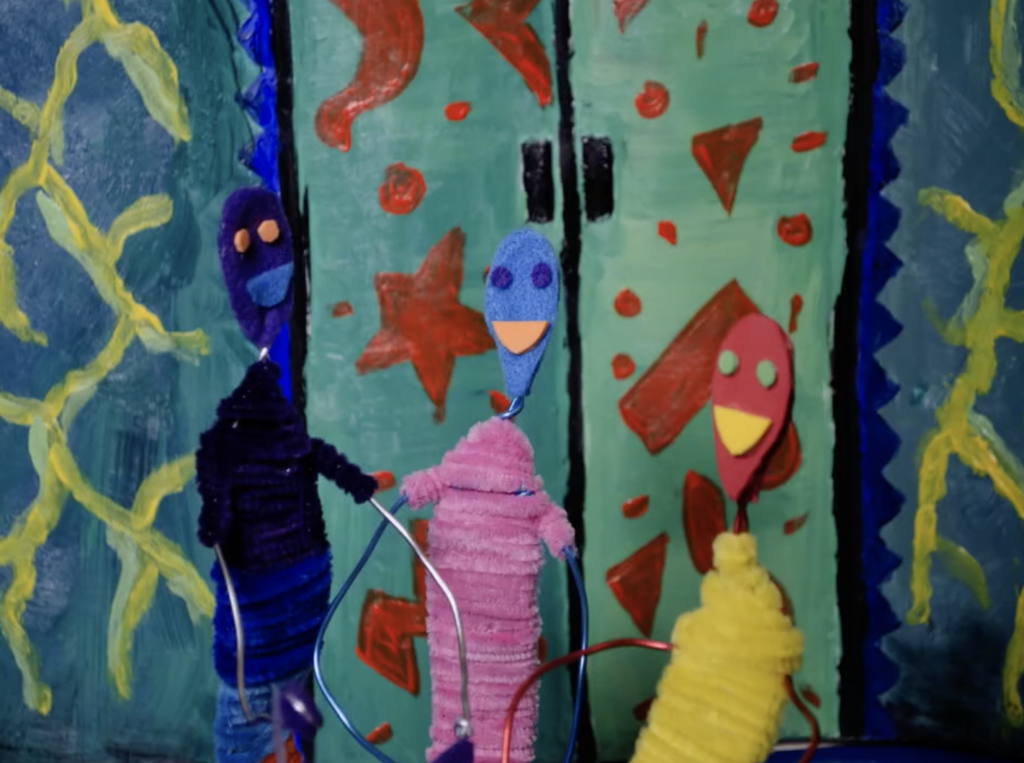
Screengrab from film by student Renata Garcia
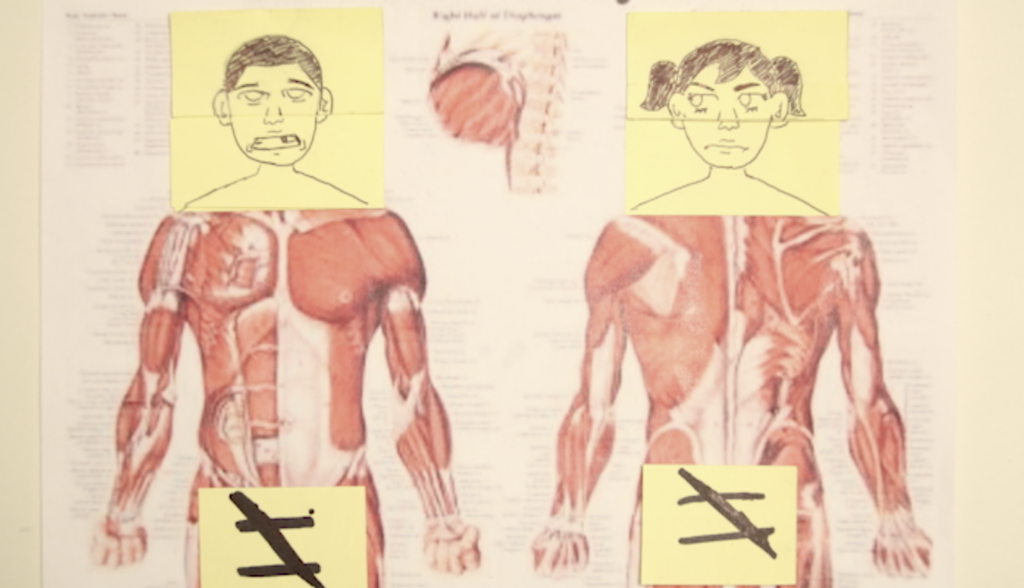
Screengrab from film by student Gary Simons

Screengrab from film by student Annie Fraser
ARTS 166 — Introduction to Animation is designed to introduce students to basic methods and practices in animation while exposing them to artists working independently in the field. The course will provide an overview of techniques ranging from hand-drawn frame-by-frame animation, to object animation and pixelation. Each class will consist of a short demonstration, viewing of related works, hands-on experimentation and critique. Weekly assignments will further students’ exploration of animation approaches and techniques. The course will conclude with the creation of final projects in which students will develop and create an animated short in a medium of their choosing.
This course is taught by Professor Elyse Kelly.
ARTS 266 — Intermediate Animation
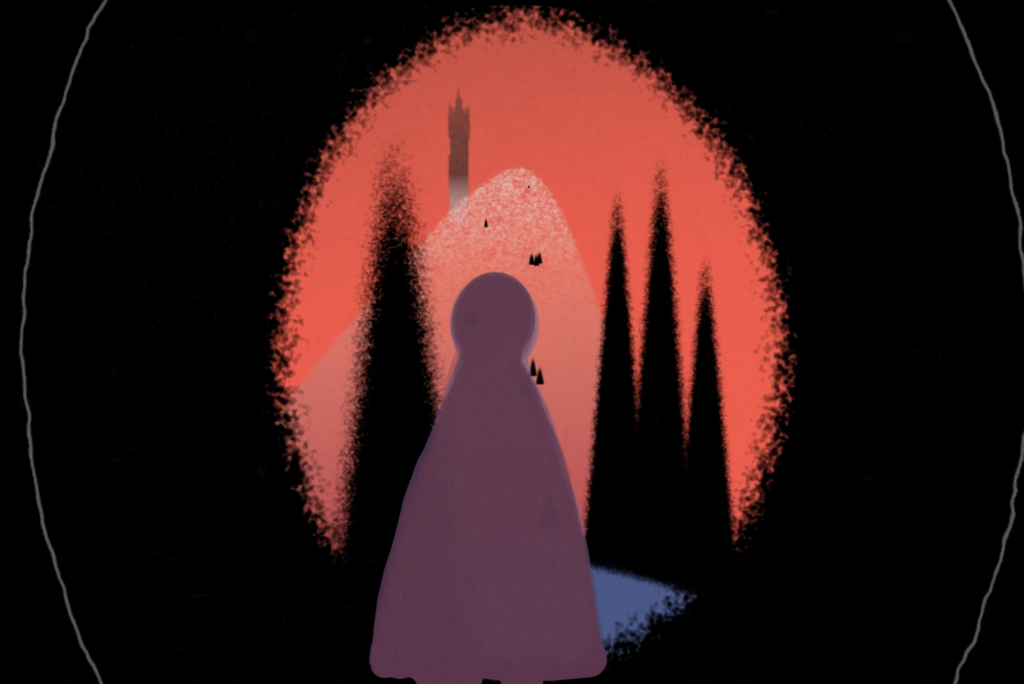
Screengrab from film by student Sarema Shorr

Screengrab from film by student Margaret Neely

Screengrab from film by student Shana Shin
ARTS 266 — Intermediate Animation This class is an intermediate course that explores experimental and traditional animation practices through exercises using 2D digital techniques. Each week will consist of a lecture, a screening of related works, and a lab. By the end of this course students will be able to execute short animations, visually express both abstract concepts and conventional narratives, and identify how animation principles affect all animated work be it digital or analog, independent or commercial, refined or rough. Students are expected to play, take risks and work outside their comfort zones.
This course is taught by Professor Elyse Kelly.
Upper-Level ARTS Courses
ARTS courses at the 330-400 level are designed primarily for Art Majors, Minors and advanced students who want to work with a professor on one or several independent projects over the course of the semester. These courses require approval. Please inquire with the individual instructor for more information.
These courses include:
ARTS 221-1 Directed Study in Printmaking – Scip Barnhart
ARTS 312-1 Drawing III: Directed Studies – Scott Hutchison
ARTS 312-2 Drawing III: Directed Studies – John Morrell
ARTS 321-1 Printmaking: Directed Study – Scip Barnhart
ARTS 330-1 Photography Studio III – Roberto Bocci
ARTS 351-2 Painting: Directed Study – BG Muhn
ARTS 351-3 Painting: Directed Study – Scott Hutchison
ARTS 351-4 Painting: Directed Study – John Morrell
ARTS 355-1 Advanced Painting Studio – BG Muhn
ARTS 355-2 Advanced Painting Studio– John Morrell
ARTS 358-1 Advanced Painting Studio II – BG Muhn
ARTS 431-1 Photography IV-Directed Study – Roberto Bocci
ARTS 435-1 Adv. Photography Studio – Roberto Bocci
ARTS 441-1 Sculpture IV: Directed Studio Studio – Evan Reed
ARTS 455-1 Adv. Painting Studio – BG Muhn
ARTS 455-2 Adv. Painting Studio – John Morrell
ARTS 470-1 Art Internship – Staff
Art History Courses
Ancient to Medieval Art

View of the Roman Forum – taken in December 2019 by Prof. Tilney
Ancient to Medieval Art surveys the art and architecture from the Paleolithic period through the Gothic period. Within a roughly chronological structure, we will explore the art of these periods in relation to their broader cultural, intellectual and historical contexts. In addition to emphasizing the developments that define each historical period, we will consider the aesthetic advances made with the painting materials and methods available at the time.
This course is taught by Professor Barrett Tilney.
ARTH 102 — Renaissance to Modern Art
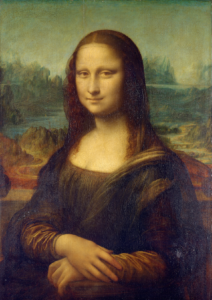
Leonardo da Vinci, Mona Lisa, c.1503 (Louvre)

Marcel Duchamp, LHOOQ, 1964 (replica of 1919 original) (Norton Simon Museum)

Andy Warhol, Four Mona Lisas, 1978 (Art Institute of Chicago)
Renaissance to Modern Art explores European and American art from the early Renaissance into the Modern Age. Within a roughly chronological structure, we will focus on a selection of artworks by major artists and their relationship to broader cultural, intellectual, and historical contexts. In addition to emphasizing the developments that define each historical period, we will also consider the aesthetic advances made with the materials and methods available at the time.
This course is taught by Professor Barrett Tilney.
ARTH 250 — Modern Architecture: US and EU

Louis Kahn. Salk Institute for Biological Studies. La Jolla, CA 1965
Modern Architecture: US and EU This course surveys modern architecture from 1750-Present. Our analysis will focus primarily on movements and designers in Europe and the United States with some additional global examples. Characteristics of key architectural styles and the designs of leading architects will be discussed within the framework of their cultural context. We will address the skyscraper’s development, the Arts & Crafts movement, the International Style and later modern forms. Visionary urban plans, new technology and architectural ornament will be highlighted. Students will work both independently and in teams throughout the semester. Included among the many architects we will address are Jefferson, Ledoux, Labrouste, Wright, Hadid, Ando and Holl. No prior architecture knowledge is required or assumed.
This course is taught by Professor Stephanie Rufino.
ARTH 254 — Modern American Art, 1865-1968

Winslow Homer, A Visit from the Old Mistress, 1876 (SAAM)
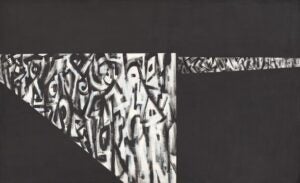
Norman Lewis, Untitled (Alabama), 1967 (NGA)

Dorothea Lange, Migrant Mother, 1936 (NMAH)
Modern American Art, 1865-1968 This course provides an introduction to American art and visual culture in the years between the Civil War and the Cold War. We will situate the images, visual practices, and artistic styles of this period within their social, historical, and cultural contexts, paying particular attention to the role that artistic production and consumption played in constructing American social identities and culture in the nineteenth and twentieth centuries. Among the topics we will consider are art and nationalism, race and representation, urbanization and industrialization, representing war, art and technology, the rise of mass media, and the role of abstraction.
This course is taught by Professor Rachel Vogel.
History of Photography
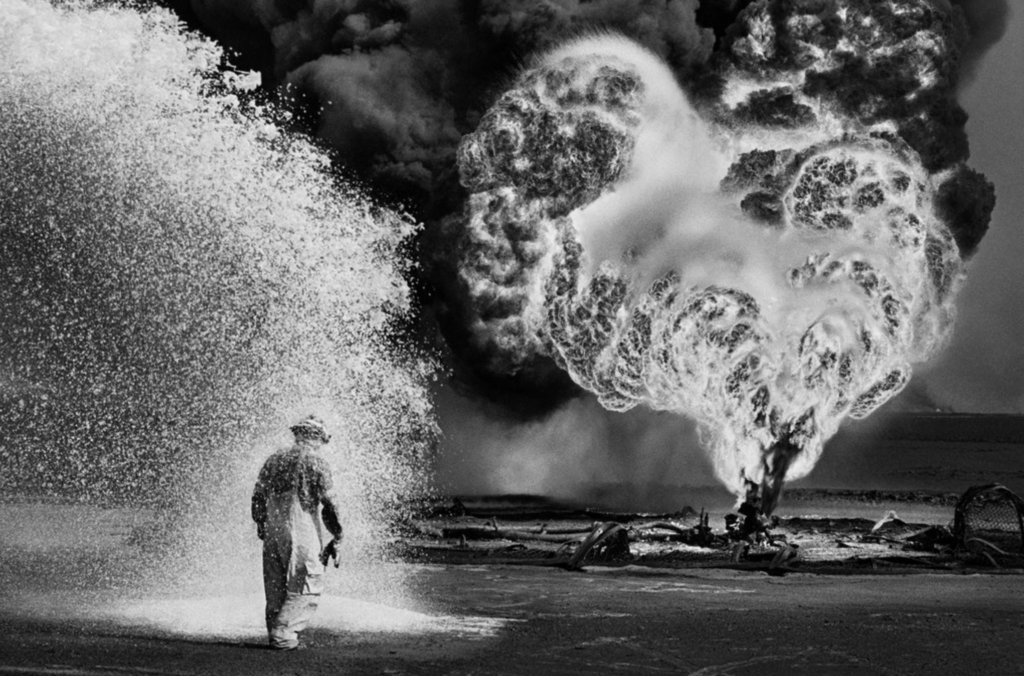
Sebastião Salgado, When the Oilfields Burned (Iraq, 1991)
History of Photography surveys the history of photography, and lens-based media generally, from its inception in 1839 through the late 20th century. Lectures are generally chronological, covering important developments—from the calotype to street photography, to drone warfare and everything between—but we will also frame our conversations around thematic problems. These include problems of equity and representation, photojournalist ethics, looking and the gaze, and the shift from analog to digital techniques.
This course is taught by Professor Ian Bourland.
ARTH 355 — Native North American Art

Northern Tsitsistas (Cheyenne) painting of the 1876 Battle of the Little Bighorn, ca. 1890s. Northern Cheyenne Reservation, Montana. Hide, paint. Photo by Ernest Amoroso, NMAI.
Native North American Art This course surveys ancient and historic Native American visual culture, as well as contemporary Native American art. It looks at what has inspired Native American artists working throughout the present-day United States and explores how those artists have responded to what they have considered the most important spiritual, cultural, aesthetic, or political issues of their times. To the greatest degree possible and through a variety of means, the class will go behind the scenes to hear directly from Native scholars, curators, and artist to examine individual expressions of visual culture and artworks. This course will also address the gulf that has long existed between Westerners and Native Americans regarding Native American visual culture and art, and examine the concepts of Indigenous aesthetics and Indigenous curation.
This course is taught by Professor Cécile Ganteaume.
ARTH 358 — Art and Power in Africa

Unidentified Kuba artists Overskirt Between 1912 – 1942 Kasaï Province, Democratic Republic of the Congo Raffia fiber, natural dyes 52″ x 23″ Private Collection.
Art and Power in Africa Throughout African history, artworks have played an important role in the construction and contestation of state power. Our course examines this relationship by surveying the artistic programs of a diverse range of pre-colonial states and societies. Drawing from readings in political theory and African art history, students will learn to closely examine individual artworks—their formal details, their circumstances of production, their histories of use and re-use—and construct a picture of political relationships. Although a background in either African studies or art history is helpful, it is by no means required.
This course is taught by Professor Kevin Tervala.
ARTH 375 — Art of the Silk Routes
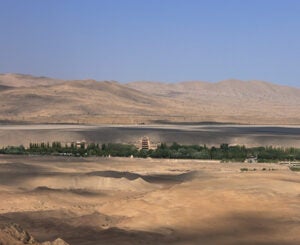
Mogao Caves, Dunhuang, Gansu Province

Gold plaque of a mounted Scythian, Black Sea region, c. 400–350 BCE, The State Hermitage Museum, St Petersburg
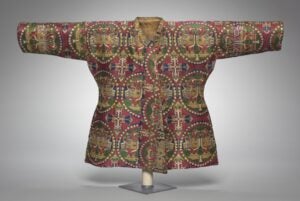
Child’s coat, silk twill weave, 700s, Sogdian, Cleveland Museum of Art, 1996.2.1
Art of the Silk Routes This course focuses on the cultural heritage of the overland and maritime silk routes. The silk routes served as a conduit for commercial trade and cultural exchange between China, Central Asia, India and Southeast Asia, and Europe. In addition to mural paintings in the Buddhist cave shrines of northwestern China, we will also study portable paintings, manuscripts, textiles, ceramics, and architecture. We will put these artifacts into context by imagining how they interfaced with the rulers, monks, traders, and nomads who traveled and lived along the silk routes.
This course is taught by Professor Michelle Wang.
ARTH 433 — Critical Theory for Visual Art

Activists at the Whitney Museum of American Art, 2019. Photograph by Erik McGregor / Pacific Press / Alamy
Critical Theory for Visual Art This course is designed to familiarize upper-level students with key texts in philosophy, critical theory, and more recent modes of political address commonly seen in art and writing about art. On one hand, understanding such concepts is vital for success in the contemporary art world; on the other, they (and the analytic skills developed in the course) are widely applicable when making sense the current cultural landscape in the US and beyond.
This course is taught by Professor Ian Bourland.
ARTH 448 — World War I and the Artists

Paul Nash, Void, 1918
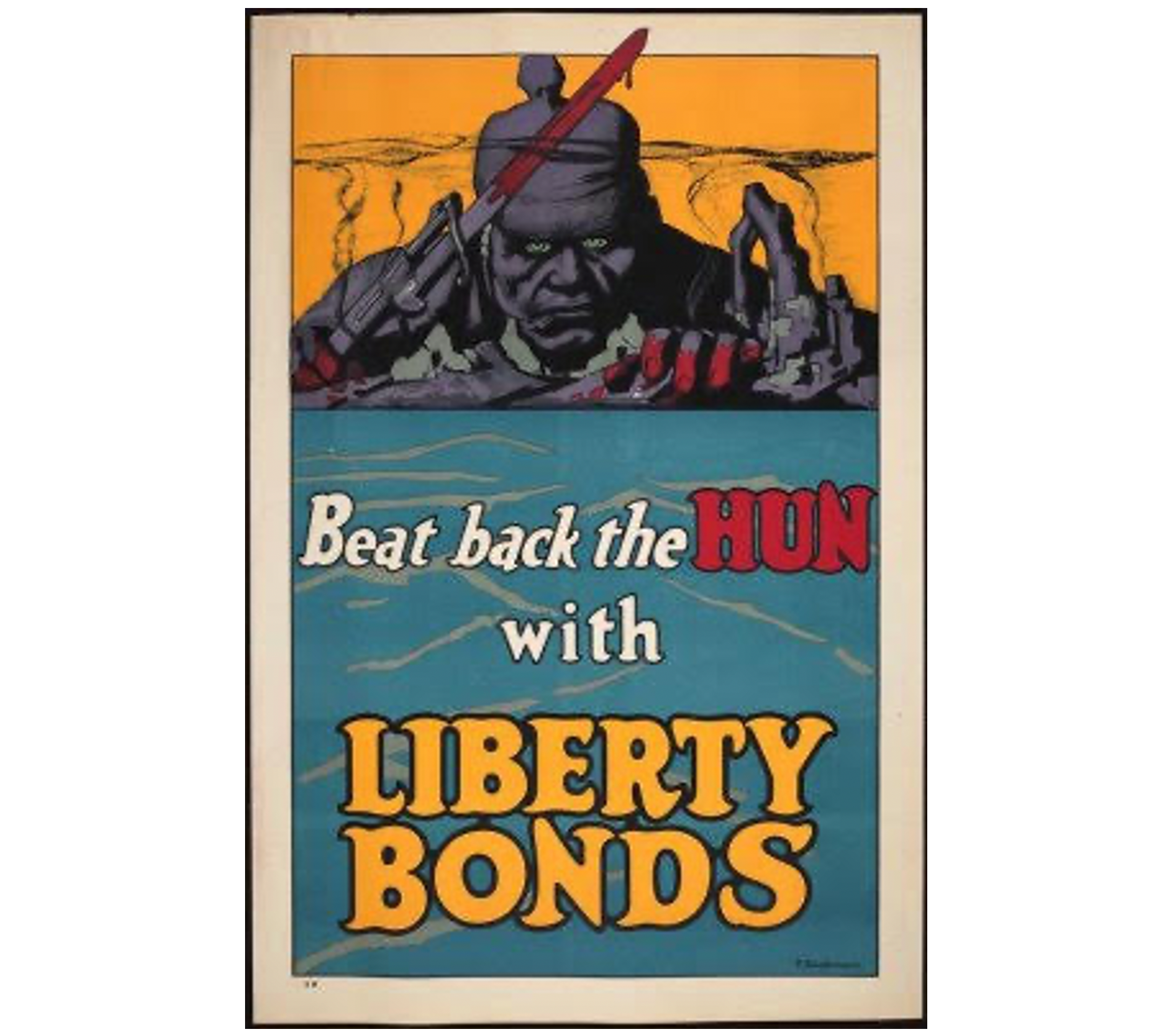
F. Strothmann, Beat Back the Hun with Liberty Bonds, 1918

Otto Dix, Wounded, 1923
World War I and the Artists On June 18, 1914, Archduke Franz-Ferdinand, heir to the throne of the Austro-Hungarian empire, and his wife the Archduchess Sophie were assassinated during a visit to Sarajevo in Bosnia-Herzegovina. The event sparked a catastrophic “total war” that spread across the globe, bringing down four long-lived multinational empires, and reconfiguring the geopolitics of the world in ways that continue to affect us today. Goaded by compelling propaganda, youth of all belligerent nations eagerly volunteered to fight. But the realities of trench warfare, and such newly invented barbarities as poison gas, soon led to doubt, disillusionment, and despair, and the death and wounding of some 40 million people. The War occasioned an astonishing amount of visual and literary culture. Artists, poets, novelists, and ordinary people of every belligerent nation reacted to the conflict, struggling to identify artistic languages adequate to convey both the utter novelty and the horror of their experience. In this seminar, we will examine the creative legacy of the War in works by European and American artists in various media: original prints and paintings, propaganda posters, film, poetry, music, and novels. We will visit Georgetown’s own Special Collections and there may be guest lecturers.
ARTH 476 — Arts of Zen Buddhism

Daitokuji Temple, Kyoto, Japan
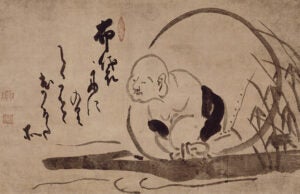
Hakuin Ekaku, Hotei on a Boat, Edo period (1615-1868), hanging scroll, ink on paper, Manyo’an Collection, 1998.56

Black Raku ware tea bowl, Momoyama period (1573-1615), pottery with black Raku glaze, black lacquer repairs, Freer Gallery of Art, F1902.52
Arts of Zen Buddhism Zen Buddhism is one of the major traditions of Buddhism in East Asia and was moreover an instrumental force in shaping modern perceptions of Japan in the west. Over the course of the semester, we will analyze how the perceived distinctiveness of Zen Buddhism – as marked by concepts such as mind-to-mind transmission, master-disciple lineage, and sudden enlightenment – was constructed through the visual arts and how the arts in turn contributed to monk-patron relations and the cultural lives of monks outside the monastic walls. Among the weekly topics to be covered are: ink landscape paintings, portraits of Zen masters, the tea ceremony and ceramic tea wares, as well as Beat Zen and the impact of Buddhism upon postwar artists in the United States.
This course is taught by Professor Michelle Wang.
Art & Museum Studies Courses
AMUS 508 — American Women Printmakers
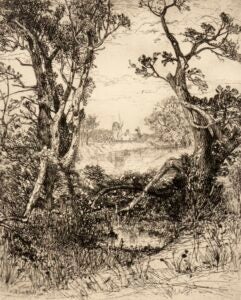
Mary Nimmo Moran, Summer, Suffolk Co. NY, 1883, Etching on paper, 150 x 102 mm, Georgetown University Art Collection, 1111.1.2920
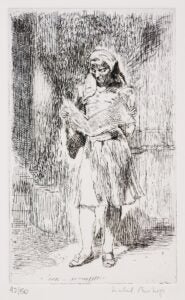
Isabel Bishop, Girl with Newspaper, 1949, Etching on paper, 188 x 113 mm, Georgetown University Art Collection, 1978.2.1
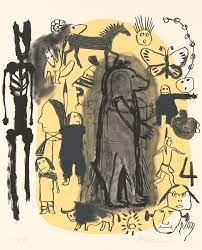
Jaune Quick-to-See Smith, 1997, Lithograph on paper, 670.5 x 550.5 mm (sheet), Georgetown University Art Collection, Fairchild Endowment Fund purchase, 2011.24.2
AMUS 508 — American Women Printmakers In this course, we will examine the work of American women printmakers, with a focus on artists represented in the Georgetown University Art Collections. We will study the different forms of printmaking and consider art historical issues specific to prints, including duplication, circulation and reception. We will also consider the history of modern American women artists’ involvement in printmaking. Throughout the course, we will investigate the role of the curator and address the duties and challenges of the curatorial field. The course will culminate in the planning and preparation of a student-curated exhibition, which will be installed in summer 2022 in the Booth Family Center for Special Collections.
This course is taught by Professors Lisa Strong, LuLen Walker & Christen Runge.
AMUS 509 — Museums & Community Engagement

Community Tour of ‘Forward Ever. Backwards Never exhibit’ at Weeksville Heritage Center.
Photo Credit: Dominique Sindayiganza Photography.
AMUS 509 — Museums & Community Engagement focuses on the lifecycle of outreach, participation, and impact, communicated between museums and audiences through a lens of equity. The course is a practical exploration of museums’ complex conjunctions with the space they steward and the publics they serve through the lens of the community. In our increasingly polarized world where societal upheaval and public institutional critique have become the norm, many museums are pivoting to more holistically serve and help visitors interpret and interrogate the world through a lens of social justice. Museums & Community Engagement will feature case studies, readings, and guest lectures that speak to ways institutions enrich, educate, and partner on programs with diverse audiences. Students will learn, deconstruct, and redefine “community” and who and what that encompasses to further illustrate efforts around programs and partnerships from every angle.
This course is taught by Professor Monica Montgomery.
Spring Internship

Frances Williams (MA ’19) curating the Art Collection, Booth Family Special Collections
AMUS 531 — Spring Internship Internship in museums or arts organizations.
Museum Administration

Art Institute of Chicago

Hillwood Estate, Museum and Gardens

Glenstone Museum
AMUS 550 — Museum Administration The many facets of leadership and management in a museum setting are explored through topics including nonprofit organization governance, board/staff relations, strategic planning, financial and human resources management, and diverse community stakeholders. The course introduces the basic components of financial statements of special interest to government oversight agencies and funders. Students develop and write grant proposals with corresponding project budgets. Course sessions on institutional planning address emergency management scenarios. Guest speakers share unique expertise gleaned from hands-on experience in museum administration roles. Students learn about current and new management tools to support how museums respond to social change through understanding organizational and community contexts, informed decision-making about collections, interpretation and programming, and garnering public and private support.
This course is taught by Professor Carma Fauntleroy.

